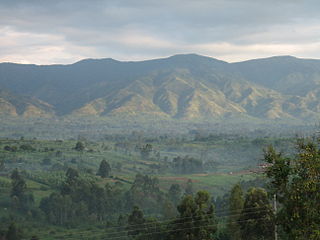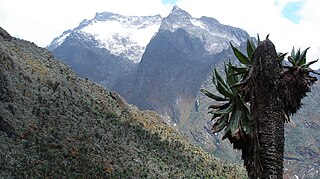
Senecio is a genus of flowering plants in the daisy family (Asteraceae) that includes ragworts and groundsels.

The Ruwenzori, also spelled Rwenzori and Rwenjura, or Rwenzururu are a range of mountains in eastern equatorial Africa, located on the border between Uganda and the Democratic Republic of the Congo. The highest peak of the Ruwenzori reaches 5,109 metres (16,762 ft), and the range's upper regions are permanently snow-capped and glaciated. Rivers fed by mountain streams form one of the sources of the Nile. Because of this, European explorers linked the Ruwenzori with the legendary Mountains of the Moon, claimed by the Greek scholar Ptolemy as the source of the Nile. Virunga National Park in eastern DR Congo and Rwenzori Mountains National Park in southwestern Uganda are located within the range.

Rwenzori Mountains National Park is a Ugandan national park and UNESCO World Heritage Site located in the Rwenzori Mountains. Almost 1,000 km2 (386 sq mi) in size, the park has Africa's third highest mountain peak and many waterfalls, lakes, and glaciers. The park is known for its beautiful plant life.

Dendrosenecio is a genus of flowering plants in the sunflower family. It is a segregate of Senecio, in which it formed the subgenus Dendrosenecio. Its members, the giant groundsels, are native to the higher altitude zones of ten mountain groups in equatorial East Africa, where they form a conspicuous element of the flora.

Mimulopsis is a genus in the flowering plant family Acanthaceae with about 30 species native to tropical Africa and Madagascar.

Mimulopsis solmsii is a flowering plant from the family Acanthaceae. It is a native to the mountains of tropical Africa. It is the type species for the genus Mimulopsis.
Mimulopsis arborescens is a tree from the family Acanthaceae and a species of the genus Mimulopsis. This tree is one of the species that can be found at Rwenzori Mountains.

Scadoxus cyrtanthiflorus is a herbaceous plant endemic to the Rwenzori Mountains of east tropical Africa. Unusually for the genus Scadoxus its tubular blooms are pendant. It is sometimes grown as an ornamental plant in heated greenhouses.

Disa stairsii is a species of Disa of the family Orchidaceae that can be found growing with the giant heathers on the Rwenzori Mountains of mountains in East Tropical Africa as well as in the Congo in West-Central Tropical Africa.
Senecio transmarinus is a sometimes straggling member of the flowering plants Asteraceae and species of the genus Senecio a perennial herb that grows on the higher elevations of the Rwenzori Mountains in Uganda. It is also found in Rwanda and the Democratic Republic of the Congo. The inflorescences consist of several flowerheads with large yellow ray florets.

Afrosciadium kerstenii, synonym Peucedanum kerstenii, is a member of the carrot family, Apiaceae. It is native to east tropical Africa and the Democratic Republic of the Congo (Zaïre). It grows among the giant groundsels (Dendrosenecio) atop of the mountains of east Africa: Mount Kilimanjaro, Mount Kenya, Rwenzori Mountains and the Virunga Volcanoes.
Galium ruwenzoriense is a member of the family Rubiaceae which grows at the mid-altitudes of 2,700 to 4,050 meters in Uganda, Kenya, Tanzania, Rwanda and Zaïre.

Oldeania alpina, the African alpine bamboo, is a perennial bamboo of the family Poaceae and the genus Yushania. It can be found growing in dense but not large stands on the mountains and volcanoes surrounding the East African Rift between 2,500 meters and 3,300 meters elevation.
Senecio maranguensis a 2-meter (6 foot) woody shrub or 6 meter (20 feet) climbing shrub from the family Asteraceae and species of the genus Senecio which makes its home at the same altitudes as the bamboo on the slopes of the mountains in East Africa.
Senecio mattirolii is a perennial herb of the family Asteraceae endemic to altitudes between 3600–4500 meters on the slopes of the mountains of the Ruwenzori Mountains in Uganda and the Democratic Republic of the Congo and an atypical species of the genus Senecio because it has purple flowers.
Dendrosenecio erici-rosenii one of the East African giant groundsel and this one can be found on the Rwenzori Mountains, Virunga Mountains and the Mitumba Mountains. It is a species of the genus Dendrosenecio and is also a collection of reclassified Senecio species.

Dendrosenecio adnivalis is one of the giant groundsels of the mountains of Eastern Africa. D. adnivalis grows on the Rwenzori Mountains and on the Virunga Mountains in Uganda and the Democratic Republic of Congo.

Diastella is a genus containing seven species of flowering plants, commonly known as “silkypuffs”, in the protea family. The name comes from the Greek diastellein “to separate”, with reference to the free perianth lobes – the plants are distinguished from the closely related and similar leucospermums by the possession of four free perianth segments. The genus is endemic to the Cape Floristic Region of South Africa where it has a very limited range and is associated with fynbos habitats. The species are all small shrubs. Most species are threatened.

Protea intonsa, also known as the tufted sugarbush, is a flowering plant of the genus Protea within the family Proteaceae, endemic to South Africa, where it is distributed from the eastern Swartberg and Kammanassie Mountains to the Baviaanskloof mountains. In Afrikaans it is known as klossie-suikerbos.
Erica trimera is a species of flowering plant. It is a shrub or tree which grows in the mountains of eastern and central Africa.











